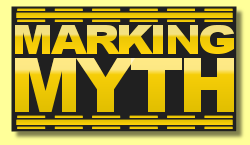 |
 |
Marking Myth - All Equipment Is Created EqualBy Donna SpeidelIn our first day of our Airfield Marking Symposiums, we take the time to address some common misconceptions prevalent in our industry - marking myths, if you will. These myths are in large part responsible for why airport markings are not as good as they should and could be. Today, I'm busting the myth, "All Equipment Is Created Equal":
In my time consulting with airports, the majority do not have the proper tools to perform the job. When we train airport personnel, we are often greeted by several friendly folks eager to learn, holding kitchen knives (to continue the analogy). It's a little more challenging to install a higher standard when the equipment provided is substandard. Snowplows are good for removing snow. Plows and brooms are effective for removing snow and clearing pavements; it's what they were designed to do. Occasionally, airports tout their plows for being multi-functional because they remove old, thick layers of paint from markings being painted year after year after year. Sure, you might be getting the last couple decades worth of paint off the top, but underneath, markings applied during TWA's reign are still hanging on for dear life. There are several paint removal equipment options available to you ranging in size, production, and budget. Small machines paint the entire airport. If you're a relatively small facility with mostly six or twelve inch wide markings, a small machine could be able to handle all your maintenance. However, too many large hub airports are depending on multiple ride-on or walk behind machines to paint everything. As soon as you graduate to the wider markings (e.g. three feet and wider), you also should graduate to a truck mounted system. Just as if you want to accommodate wider aircraft, you have to graduate to the next Taxiway Design Group... it's the same concept. I urge airports to gather as many resources as possible when researching equipment. Too often I've seen medium and large airports acquire assets that ultimately don't fit their needs. Be wary of any equipment that is being touted to apply paint (not water) three feet wide with three spray guns or less (airless or pneumatic); wider markings generally need four to six paint guns and bead dispensers. Most paint truck manufacturers build for the larger highway markets and are not exactly what your airport needs; the salesman may not understand what you need, but will still "round peg" you. Spec equipment that will make your pavement marking program its most efficient (we'll help!). [Equipment that didnít make the article: surface preparation, bead dispensers, stencils, airless tips...] You need to gather the available information and options to make an educated choice. Before pulling the trigger on your next big investment, get a second (unbiased, expert) opinion. If you need to hear it from a counterpart, we'll introduce you to the right airport folks. Choosing the perfect "screwdriver" for your airport is a big consideration, and not all equipment is created equal. Helping you make the right choice is just one benefit of getting your own Airfield Marking Audit. Change your stripes in 2014. |

 Having the right tool for the job is a mantra my father drummed into our heads. My mother even railed against using a
kitchen knife as a screwdriver to tighten the occasional cabinet screw. In a pinch you have to use what is available to you, but when
a project calls for a screwdriver, put away your kitchen knives.
Having the right tool for the job is a mantra my father drummed into our heads. My mother even railed against using a
kitchen knife as a screwdriver to tighten the occasional cabinet screw. In a pinch you have to use what is available to you, but when
a project calls for a screwdriver, put away your kitchen knives.